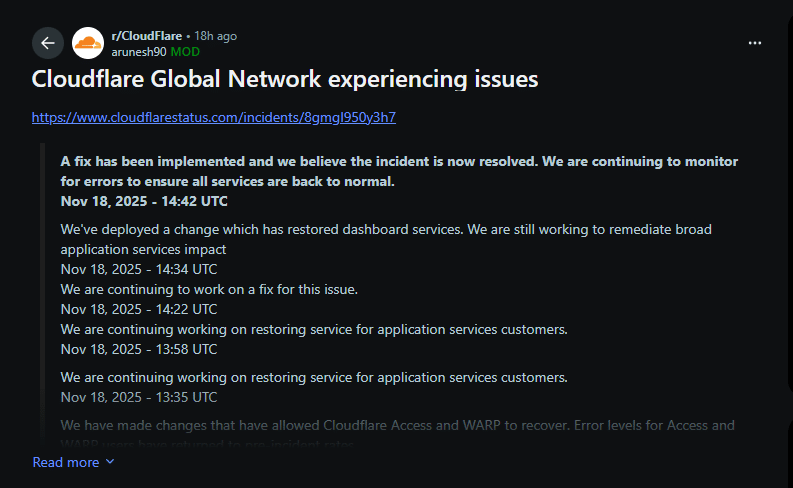This article was first published on Deythere.
On 18 November 2025, a widespread Cloudflare outage caused major disruptions across the web, including in the crypto space. According to the source, the root cause traced back to a software crash, not a cyberattack caused by an oversized configuration file in Cloudflare’s internal systems.
Cloudflare said that a “feature file” used by its bot-management service grew too large after a change in database permissions, triggering a cascade of 500-level errors across its network. The company blamed a latent bug and apologized for letting down customers and the broader internet.
What Led to the Cloudflare Outage
Cloudflare’s status page logged the incident as “internal service degradation” beginning around 11:48 UTC. Engineers discovered that a configuration file used in threat-traffic management had ballooned far beyond its expected size. The inflated file caused proxy software to crash when handling bot-detection traffic.
As stated by Cloudflare, the file that caused the issue spread all over its network and had a negative impact on essential services like the dashboard, API, Workers and firewall modules. The fix was implemented by approximately 14:57 UTC and the main services started to recover.
Cloudflare noted that some customers might still face issues while the company monitors for residual errors.
Which Crypto Services Were Impacted
The Cloudflare outage struck several well-known crypto sites. CoinDesk reported that Arbiscan and DefiLlama displayed error 500 pages. BitMEX also confirmed front-end issues.
Trading platforms that rely on Web3 front ends saw disruption, though some exchanges said their on-chain systems continued to operate normally. Users on social media (X) noted that even critical dashboards and explorers were temporarily unreachable.
Timeline At a Glance
| Time (UTC) | Event |
|---|---|
| ~11:48 | Cloudflare detects internal degradation. |
| ~12:03 | Error reports surge; dashboard and API fail. |
| ~14:42 | Fix implemented; dashboard begins recovery. |
| ~14:57 | Cloudflare declares main outage resolved. |
| ~19:42 (local UTC-converted) | Cloudflare posts final update confirming monitoring continues. |

Why This Matters for Crypto
The outage exposed how much even crypto front ends depend on centralized web infrastructure. When Cloudflare’s systems faltered, many of the most widely used blockchain explorers and trading dashboards failed to load. Users saw error messages, and accessibility dropped sharply.
This incident raises a red flag for crypto developers: relying solely on a single CDN or traffic provider poses real risk. As many in the Web3 space know, downtime doesn’t just slow things down; it can shake user trust and freeze critical operations.
Lessons and Action Items
- Utilize a Multi-CDN Approach: It is advisable for cryptocurrency platforms to direct their traffic through various CDNs as a means of preventing a single point of failure in the system.
- Construct Strong Front Ends: Create user interfaces that are capable of reversion to basic versions or utilizing cached data when the primary systems go down.
- Operate Separate Nodes: Trading platforms and decentralized finance (DeFi) projects should either set up their own nodes or depend on a decentralized network in order to minimize reliance on outside suppliers.
- Insist on Openess: Services like Cloudflare should make available comprehensive postmortems so that the developers can acquire knowledge and reinforce their systems.
Conclusion
The Cloudflare outage on the 18th of November, 2025, served as a wake-up call, indicating that even high-quality infrastructure could not escape from internal glitches. A configuration file that expanded its size massively caused the downfall of major web services, including the crypto platforms that were most vitally used.
Cloudflare acted promptly to rectify the situation, but the incident reflects a more profound reality which is the fact that decentralization is not just a migration to blockchain but also a spreading of front-end dependencies in different places. The crypto sector needs to think of building for devolution as well as for resilience.
Glossary of Key Terms
- Configuration File: A document that tells software how to behave.
- Bot Management: A System that helps block or score suspicious automated traffic.
- Error 500: A server-side problem that stops a page from loading correctly.
- CDN (Content Delivery Network): A Network that delivers web content from servers close to users.
FAQs Regarding Cloudflare Outage
1. Was the Cloudflare outage caused by a cyberattack?
No, Cloudflare clearly stated that the outage was caused by a software bug, not malicious activity.
2. Which crypto sites went down?
Arbiscan, DefiLlama, and BitMEX all reported front-end disruptions during the Cloudflare outage.
3. Did blockchain transactions stop?
No. Some exchanges reported that their backend and on-chain systems continued to operate despite front-end issues.
4. How long did the outage last?
It began around 11:48 UTC, and core services were back by 14:57 UTC.



















































































































